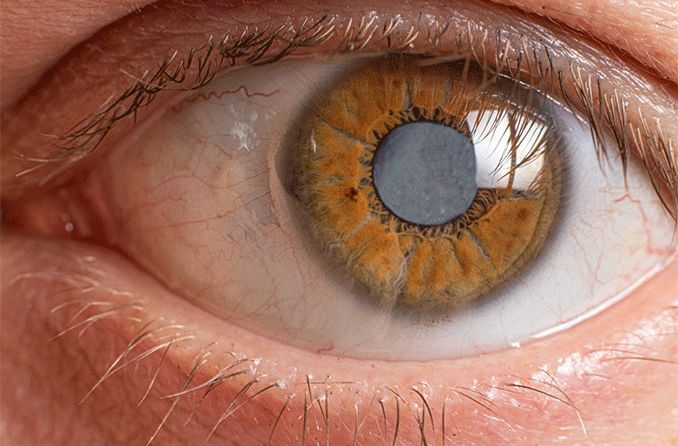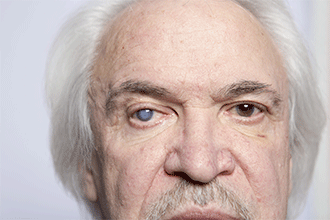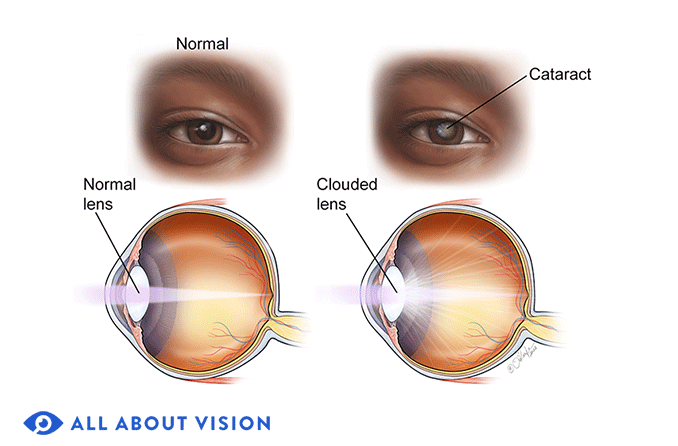What do cataracts look like?

Can you see cataracts?
A cataract is a clouding of the eye’s natural, crystalline lens. You cannot see a cataract until it is very advanced — called a “mature cataract.” An eye with a mature cataract will appear milky white or brown and opaque and can be seen in someone’s eye or in your own eye in the mirror.
Even when a cataract is in its earliest stage, your eye doctor should see it in the cataracts test during a comprehensive eye exam. They will also be able to tell what type of cataract you have as well as how advanced it is.
What do cataracts look like at each stage?
There are four stages of cataracts, and each has a different appearance.
The stages are:

Higher grade cataracts can make the pupil look white or gray instead of black.
Early cataract – Most of the lens of your eye is still clear. However, vision may be affected. Cloudy or blurred vision, as well as glare when looking at light sources and eye strain are all possible.
Immature cataract – The lens is now a bit opaque and clouded, particularly in the center. An immature cataract may take years to progress.
Mature cataract – The cataract has developed so much that the lens may appear milky white, or brown and opaque. You can no longer distinguish the dark ring around the iris of the eye.
Hypermature cataract – At this point, the cataract is so advanced it is hard, thick and brown. At this stage, cataracts are more difficult to remove. The lens also shrinks and eye pressure can increase, which may lead to glaucoma.
Each type of cataract looks unique
There are several types of cataracts. Each type of cataract starts in a different part of the lens. Each grows in a unique way and has a distinct appearance.
Cataracts that begin in the center of the lens
Cataracts that start in the center of the lens are called nuclear cataracts. They are the most common form of cataract, and will grow very slowly over a period of years.

Illustrated by Laurie O'Keefe
Nuclear cataracts can be very small at first, and may not impair vision until they have grown larger and cover other layers of the eye.
As nuclear cataracts grow, they will appear to have a yellow hue that your eye doctor can identify. This yellow hue, which eventually turns brown, is called brunescence. There are five grades (from trace to 4+) of nuclear cataract brunescence:
Trace – the cataract has a faint yellow hue
Grade 1+ – the cataract is pale yellow
Grade 2+ – the cataract is bright yellow
Grade 3+ – the cataract is a deep, dark yellow
Grade 4+ – the cataract has turned brown
Cataracts that begin in the back of the lens
Cataracts that form on the back of the lens are called posterior subcapsular cataracts. Your eye doctor will see a small, cloudy area in the back of the lens. These cataracts tend to grow quickly and block light passing onto the retina. They also tend to disrupt near vision and are more common in younger people.
Posterior subcapsular cataracts are graded as follows:
Trace – almost no clouding
Grade 1+ – less than 5% of the posterior capsule is clouded
Grade 2+ – about 30% of the posterior capsule is clouded
Grade 3+ – when 50% of the posterior capsule is clouded
Grade 4+ – when more than 50% of the posterior capsule is clouded
Cataracts that begin at the edge of the lens
Cataracts that start growing at the outer edge of the lens are called cortical cataracts. They will look like white, triangular streaks on the lens’ outer edge and resemble spokes.

The spoke-like streaks will steadily grow toward the center of the lens until they interfere with light passing onto the retina.
Cortical cataracts are graded as such:
Trace – very few streaks
Grade 1+ – less than 10% of the lens shows streaks
Grade 2+ – 10-50% of the lens shows streaks
Grade 3+ – 50-90% of the lens shows streaks
Traumatic cataracts
A traumatic cataract is caused by direct trauma or injury to the eye.
When the eye has been pierced or severely injured, the cataract often resembles a rosette or a sharp-edged flower. The cataract may be small and localized. Other times, a traumatic cataract may encompass the lens.
Other types of cataracts
A diabetic cataract is also known as a snowflake cataract. It has white spots and streaks that look like snowflakes. A diabetic cataract can also appear in the back of the lens — a posterior subcapsular cataract.
A congenital cataract is one that a baby is born with. A congenital cataract my be visible because the pupil will look white or greyish.
A pediatric cataract occurs in children, and can show up in different parts of the lens. Pediatric cataracts resemble thick clouds or small dots.
A Christmas tree cataract has red, green and gold sparkles that cloud the lens. This type of cataract is named after Christmas tinsel. These can occur when someone has a condition called myotonic dystrophy.
A secondary cataract is not really a cataract. It occurs after cataract surgery, when the capsule in your eye that holds the artificial lens begins to grow new cells. These new cells can cloud vision. This type of ‘cataract’ is easily treated with an office procedure.
READ NEXT: What are the symptoms of cataracts?
Brunescent cataract. EyeRounds.org — University of Iowa Health Care. October 2013.
Can you see cataracts in mirror? NVISION. January 2021.
Cataract symptoms — When should you see the doctor? Oregon Eye Specialists. July 2012.
Cataract progression rate: 4 stages of cataract development. Southwestern Eye Center. August 2019.
31 flavors of cataracts. OptometryStudents.com. September 2020.
What are the three types of cataracts? Eye Associates of Tucson. Accessed August 2021.
Traumatic cataracts. Medscape. September 2018.
Snowflake cataracts. American Academy of Ophthalmology. February 2014.
Congenital cataracts. Nemours KidsHealth. October 2019.
Pediatric cataracts. American Academy of Ophthalmology. March 2021.
What do cataracts look like? American Academy of Ophthalmology. May 2020.
Christmas tree cataract. American Academy of Ophthalmology: Eyenet Magazine. January 2016.
Types of cataract. National Eye Institute. August 2019.
Page published on Tuesday, October 5, 2021
Medically reviewed on Friday, September 17, 2021




